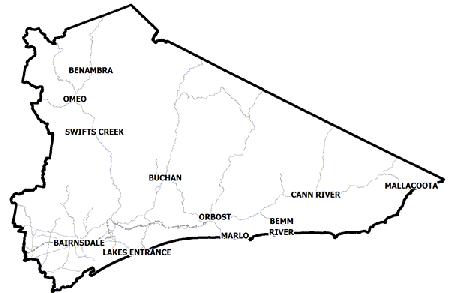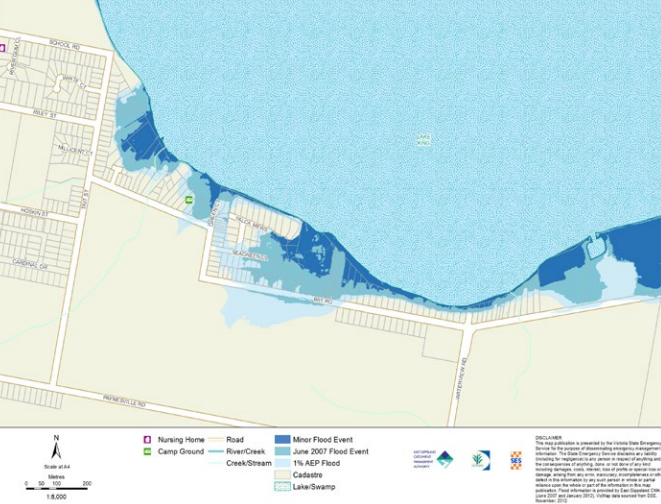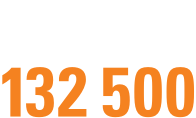East Gippsland Shire Council
Flood information for the East Gippsland Shire Council, encompassing local flood guides for: Bairnsdale, Buchan Valley, Genoa, Lakes Entrance, Eagle Point, Metung, Paynesville, Snowy River/Orbost and Raymond Island as well as the East Gippsland Shire Municipal Flood and Emergency Plan.
East Gippsland Flood History
East Gippsland is home to the Genoa, Cann, Bemm, Tambo, Nicholson, Snowy, Buchan and

Mitchell Rivers and the Gippsland Lakes. Weather systems commonly referred to as East Coast Lows can produce heavy rainfall on frequent occasions which can lead to minor riverine flooding with major flood events in both the rivers and lakes occurring more rarely.
For example, during June 2007, four major east coast lows occurred in succession with each one producing heavy rainfall. The last east coast low brought up to 300mm of rainfall resulting in major riverine flooding across the Council area and the Gippsland Lakes rising 1.3m above normal levels.
A significant risk is isolation of communities, vehicles and recreational visitors through the area when rivers and creeks rise, landslips and falling vegetation make roads impassable. Storms can also cause power and communication outages simultaneous to flooding.
Mossiface to Swan Reach Local Flood Guide
Are you at risk of flood?
The Tambo River runs downstream from Bruthen, passing through several small townships including Mossiface, Tambo Upper, Bumberrah, Swan Reach and Johnsonville/Tambo Estate, before flowing into Gippsland Lakes at Lake King, west of Metung.
Many properties and roads are at risk of being inundated from high floodwaters, particularly those low on the floodplain.
When Tambo River floods, water quickly begins to pool in the floodplain south of Bruthen and the depth of floodwater increases as water builds up downstream.
Relatively small floods result in water spilling into the old Tambo River watercourse, which reconnects to Tambo River just over a kilometre north of Fred Albert Bridge (Stephenson Road, Tambo Upper)
Eagle Point Local Flood Guide
Are you at risk of flood?

The Gippsland Lakes have a history of flooding. In Eagle Point, low-lying community infrastructure such as boat ramps, car parks and jetties are impacted by flooding from both the Mitchell River and Gippsland Lakes.
Boat ramps, jetties and car parks flood early which can cause unwary boat owners to return and find their cars flooded.
Properties along the Mitchell River Silt Jetties are generally isolated early due to high velocity flows from the Mitchell River.
The properties most at risk are on Rivermouth Road on the Silt Jetties between the Mitchell River and Lake King, and those facing Lake King along Bay Road. Boats in marinas and jetties will need their mooring lines adjusted as the lake heights build and recede.
The map to the right shows likely flooding at the Minor Flood Level, the 2007 flood event and the effects of a 1% flood in Eagle Point. A 1% flood means there is a 1% chance of a flood this size occurring in any year.
Lakes Entrance Local Flood Guide
Are you at risk of flood?
The Gippsland Lakes have a history of flooding. In Eagle Point, low-lying community infrastructure such as boat ramps, car parks and jetties are impacted by flooding from both the Mitchell River and Gippsland Lakes.
Boat ramps, jetties and car parks flood early which can cause unwary boat owners to return and find their cars flooded.
Properties along the Mitchell River Silt Jetties are generally isolated early due to high velocity flows from the Mitchell River.
The properties most at risk are on Rivermouth Road on the Silt Jetties between the Mitchell River and Lake King, and those facing Lake King along Bay Road. Boats in marinas and jetties will need their mooring lines adjusted as the lake heights build and recede.
The map above below shows the expected flooding for the Bruthen to Swan Reach area. A major flood event occurs at 10 meters on the Tambo River Ramrod Creek junction gauge, North East of Bruthen. This is what flooding would look like when experiencing a 1 in 100 year flood.
Metung Local Flood Guide
Are you at risk of flood?
Flooding typically occurs in Metung one to three days after the Latrobe, Thomson, Macalister, Avon, Mitchell, Nicholson and/or Tambo Rivers have experienced flooding.
Flood peaks will slow to rise and fall, sometimes taking up to two weeks for floodwater to recede.
Wind can increase the lake levels around Metung by up to 50 centimetres. Metung and Tambo Bay are not at risk of large numbers of properties flooding, however some roads may be closed.
Properties on Shaving Point may have some flood impact where they front onto Lake King but flooding does not normally occur above floor level.
There are many marinas and jetties around Metung where boats will need their mooring lines adjusted to accommodate the rise and fall in lake height.
Access to Metung is via the Princes Highway and Metung Road. If Metung Road becomes impassable where it follows the Tambo River below Swan Reach, alternative access is via Nungurner Road.
The map to the right shows the Minor flood level (0.8 metres), the Major level (1.9 metres) and the 1% level, meaning there is a 1% chance of this kind of flood occurring each year.
Paynesville Local Flood Guide
Are you at risk of flood?
Flooding typically occurs in the Paynesville community one to three days after the Latrobe,Thomson, Macalister, Avon, Mitchell and/or Tambo Rivers have experienced flooding.
Flood peaks are slow to rise and recede, sometimes taking up to two weeks. Wind can increase lake levels around Paynesville by up to 50 centimetres.
Many parts of Paynesville are located above the flood level, however local road closures may require residents to seek alternative routes to Bairnsdale and create access problems to local shops and businesses.
Properties on Burrabogie Island and along Slip Road are the most at risk of isolation and over floor flooding.
In Paynesville there is low-lying community infrastructure such as boat ramps, car parks, and jetties that are impacted by flooding. Boats in marinas and on jetties will need their mooring lines adjusted as the lake heights build and recede.
The map to the right shows the 2007 flood extent, which was 1.5 metres, and the Minor Flood Level, which is 0.7 metres on the McMillan Straits at Paynesville Gauge.
Raymond Island Local Flood Guide
Are you at risk of flood
Flooding typically occurs on Raymond Island one to three days after the Latrobe, Thomson,
Macalister, Avon, Mitchell, Nicholson and/or Tambo Rivers have experienced flooding.
Flood peaks are slow to rise and recede, sometimes taking up to two weeks. Wind can increase the lake levels around Raymond Island by up to 50 centimetres.
On Raymond Island there is low-lying community infrastructure such as boat ramps, car parks, and jetties that can be impacted by Gippsland Lakes flooding.
The Raymond Island Ferry stops operating at the Minor Flood Level resulting in isolation of the island which can last up to two weeks.
There are many homes and sheds in low-lying areas close to the water. These properties, along with local roads are subject to flooding at low levels. This in turn impacts on Raymond Island residents’ ability to travel within the island, causing properties to become isolated within the island. Boats in marinas and jetties will need their mooring lines adjusted as the lake heights build and recede.
The maps below show the 2007 flood extent, which was 1.5 metres at the McMillan Straits at Paynesville Gauge, and the Minor Flood Level which is 0.7 metres at the McMillan Straits at Paynesville Gauge.
Snowy River and Orbost flood guide
Are you at risk of flood?
Flooding in this community operates usually in two ways; high flows overtop the Snowy riverbank and travel across the farmland adjacent to the river, or during relatively small floods, back-flooding occurs up the ‘B drain’. The southern outskirts of Orbost (below the Princes Highway) are also highly prone to flooding due to the floodplain filling once Gilbert’s Gulch is overtopped.
Bete Bolong and Jarrahmond floodplain are highly susceptible to flooding, particularly the area downstream from Lynn’s Gulch (a low-point in the Snowy banks), where flows move toward Orbost.
- At historical outflow points, the natural levees along the riverbanks have been artificially armoured with timber and rock to reduce erosion. However, it is important to note that none of these structures weren’t built or are maintained to current engineering standards – and therefore have the potential to fail unexpectedly at any time during a flood event.
- Several floodgates exist to drain the floodplain of floodwaters while preventing backflow from the Snowy River, these are in Bete Belong, B Drain, Nixons, Newmerella and Icy Creek. It should be noted however, that these structures are no longer actively maintained, and they are unlikely to be operating effectively during future floods.
- While people local to this system may already be aware, it’s important to note the Snowy River is a continuously changing waterway that poses many risk factors. Recreational activities pursued on this waterway should be managed under professional guidance only.
- If you live in the Snowy River catchment area you may be at risk of flooding. Get ready, have a plan. Get ready, have a plan.
Bairnsdale Local Flood Guide
Are you at risk of flood?
You may be at risk of flood in Bairnsdale if you live or work at a property situated adjacent to the Mitchell River, or you require access through a road/bridge which is located near the river or low-lying floodplain. Get ready, have a plan.
Even areas far from the river may be at risk if the flood event is large enough to cause significant flooding. It pays to familiarise yourself with the following maps and read further to understand key roads and areas which may be impacted. Not every road or property can be listed, and it is important to be aware of your surroundings and understand what a flood watch or a flood warning means to you.
In general, you may have between 5 and 9 hours of warning time for peak flood waters to reach from the Glenaladale gauging station to Bairnsdale.
The Mitchell River bends around Bairnsdale and first breaks its banks at low-lying areas such as the Wy Yung Football oval, along the Mitchell River Walking Track, and at the east-end of Macleod Street.
During moderate to major events, access to the Lind Bridge may be lost along Bullumwaal and Pound Swamp Hill Road.
Major floods measuring more than 6.8 meters on the Bairnsdale gauge may cut access along Paynesville Road, downstream from the Princes Highway bridge.
For even larger and less frequent floods, greater than 8.2 meters on the Bairnsdale gauge, access along the Princes Highway Bridge at Bairnsdale may be lost due to flooding of the roads on approach to the bridge.
Buchan Valley Local Flood Guide
Are you at risk of flood?
You may be at risk of flood in the Buchan Vally if you live or work at a property situated adjacent to the Buchan River, or you require access through a road/bridge which is located near the river or low-lying floodplain. Get ready, have a plan.
The Buchan Valley (which forms part of 1214km2 catchment that includes the Murrindal River) is long and narrow, ranging from 10-25 kilometres wide and over 75 kilometres long. The whole catchment is relatively steep and vegetated with native forests, with areas of pasture alongside the Gelantipy Road and around the Buchan township.
In smaller events flooding generally remains confined within the main channel throughout the Buchan Valley area. At its widest point, the flood extends out to around 260 m across the floodplain, upstream of the township.
In larger events the Buchan township is impacted by deeper flooding, and various buildings may experience flooding above floor level with flood depths above 0.30 metres. The local football oval may also be inundated at these levels. Several roads will be closed within the township because of significant flood depths and velocities that pose a risk to the public.
Most Buchan residents are located on elevated ground, away from direct impact of flood waters.
The Buchan River travels through the township of Buchan before joining the Snowy River from the west downstream from Basin Creek.
Genoa Valley Local Flood Guide
Are you at risk of flood?
The Genoa, Wangarabell, Gipsy Point and Mallacoota communities are all impacted by riverine floods. The most common impacts are inundation of low-lying farming land and road closures. Gipsy Point and Mallacoota are isolated by closure of the Genoa-Mallacoota Road in larger flood events. There are also roads and low-lying infrastructure that can be inundated in Mallacoota. Most property infrastructure in the valley is built on higher ground so direct impact is reduced.
The largest recorded flood in the Genoa Valley was in June of 1978, although there is evidence of a larger event in 1971. Floods occur in the area because of the relatively high rainfall in Eastern Victoria and the narrow floodplain. Floods can come and go quite quickly, due to the steep catchment and the short distance downstream to the Genoa floodplain. You may not have much warning of a pending flood so it is important to keep an eye on rain upstream in the catchment.
When considering impacts of a potential flood, those living on rural properties usually allow plenty of time to move stock and machinery located on the floodplain. Hay bales are stored on high ground to avoid being washed away by flood waters. (Refer to the Genoa Flood Levels table in the Local Flood Guide below for further details of flood impact at major, moderate and minor levels.)
About Flood Guides
Communities can use local flood guides to identify and better understand their local flood risk. They include information about: flood history, how to prepare & respond to floods and who to contact.
Contact Information
Local VICSES Units
- Bairnsdale VICSES Unit
Cnr Ligar and Macleod Streets, - Bairnsdale, Victoria 3875
- Bendoc VICSES Unit
9 Jamieson Street, - Bendoc, Victoria 3888
- Bruthen VICSES Unit
Main Street, - Bruthen, Victoria 3875
- Buchan VICSES Unit
Orbost Road, - Buchan, Victoria 3885
- Cann River VICSES Unit
- Monaro Highway,
- Cann River, Victoria 3890
-
Mallacoota VICSES Unit
Lees Road, PO Box 493,
Mallacoota, Victoria 3892 - Orbost VICSES Unit
5 Wolseley Street, - Orbost, Victoria 3888
- Tambo Valley VICSES Unit
Omeo Highway, - Swifts Creek, Victoria 3896
Municipal Flood Emergency Plans (MFEP)
East Gippsland Municipal Flood Emergency Plan - Gippsland Lakes









